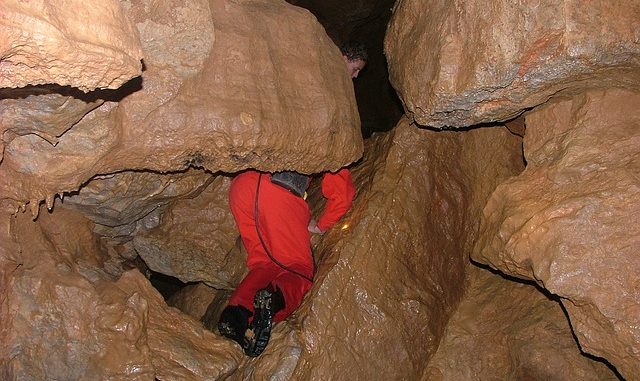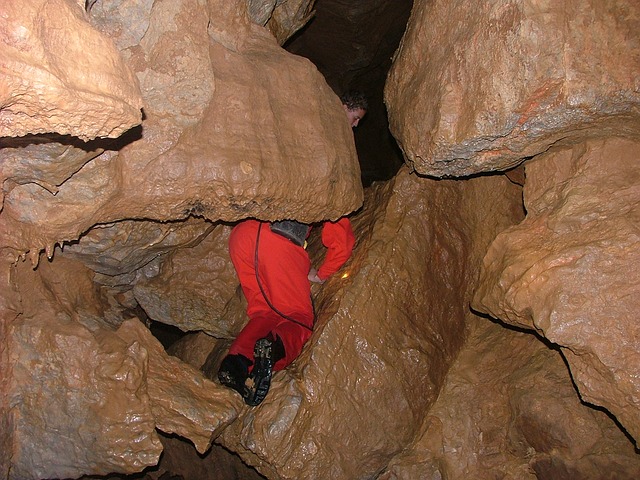
Explore the depths of the earth in tunnels so small that you have to contort your body to squeeze through the gaps. All in the pitch black.
Caving is a sport where you explore underground to discover places noone else has been before and also to test your on nerve and physical abilities. The challenges of the sport depend on the cave being visited, but often include the negotiation of pitches, squeezes, and water.
Negotiating water within caves is a speciality of caving known as cave diving, and is undertaken only by very few very experienced cavers.
Climbing or crawling is often necessary when caving, and ropes are used extensively for safety of the negotiation of particularly steep or slippery passages.
Caving is often undertaken for the enjoyment of the activity or for physical exercise, as well as original exploration, similar to mountaineering or diving. Physical or biological science is also an important goal for some cavers. Virgin cave systems comprise some of the last unexplored regions on Earth and much effort is put into trying to locate and enter them. In well-explored regions (such as most first-world countries), the most accessible caves have already been explored, and gaining access to new caves often requires digging or diving.
Caves have been explored out of necessity (for shelter from the elements or from enemies), out of curiosity or for mystical reasons for thousands of years. However, only in the last century or two has the activity developed into a sophisticated, athletic pastime. In recent decades caving has changed considerably due to the availability of modern protective wear and equipment. It has recently come to be known as an “extreme sport” by some (though not commonly considered as such by its practitioners, who may dislike the term for its perceived connotation of disregard for safety).
Many of the skills of caving can also be used in the nature activities of mine exploration and urban exploration.

Hard hats are worn to protect the head from bumps and falling rocks. The caver’s primary light source is usually mounted on the helmet in order to keep the hands free. Electric lights are most common, with halogen lamps being standard and white LEDs as the new competing technology. Many cavers carry two or more sources of light – one as primary and the others as backup in case the first fails. More often than not, a second light will be mounted to the helmet for quick transition if the primary fails. Carbide lamps systems are an older form of illumination, inspired by miner’s equipment, and are still used by some cavers.
The type of clothes worn underground varies according to the environment of the cave being explored, and the local culture. In cold caves, the caver may wear a warm base layer that retains its insulating properties when wet, such as a fleece (“furry”) suit and/or polypropylene underwear, and an oversuit of hard-wearing (e.g., cordura) and/or waterproof (e.g., PVC) material. Lighter clothing may be worn in warm caves, particularly if the cave is dry, and in tropical caves thin polypropylene clothing is used, to provide some abrasion protection whilst remaining as cool as possible. Wetsuits may be worn if the cave is particularly wet or involves stream passages. On the feet boots are worn – hiking-style boots in drier caves, or rubber boots (such as wellies) often with neoprene socks (“wetsocks”) in wetter caves. Knee-pads (and sometimes elbow-pads) are popular for protecting joints during crawls. Depending on the nature of the cave, gloves are sometimes worn to protect the hands against abrasion and/or cold. In pristine areas and for restoration, clean oversuits and powder-free, non-latex surgical gloves are used to protect the cave itself from contaminants.
Ropes are used for descending or ascending pitches (“Single Rope Technique”) or for protection. Knots commonly used in caving are the figure-of-eight- (or figure-of-nine-) loop, bowline, alpine butterfly, and Italian hitch. Ropes are usually rigged using bolts, slings, and carabiners. In some cases cavers may choose to bring and use a flexible metal ladder.
In addition to the equipment already described, cavers frequently carry packs containing first-aid kits, emergency equipment, and food. Containers for securely transporting urine are also commonly carried. On longer trips, containers for securely transporting faeces out of the cave are carried.
During very long trips, it may be necessary to camp in the cave. This necessitates the caver carrying sleeping and cooking equipment.
For more information visit caves.org
